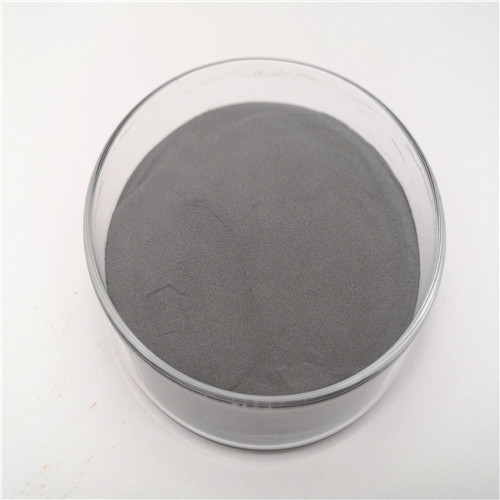The powder preparation method in which a fast-moving fluid (atomizing medium) impacts or otherwise breaks the metal or alloy liquid into fine droplets and then condenses into a solid powder is called the atomization powdering method. At present, the most widely used powdering technology is water atomization and gas atomization. Although the principle of powdering is the same, the physical properties of the powders produced vary greatly.
shape
Since the heat capacity of gas is smaller than that of water, when gas atomization is used, the alloy receives a low degree of chill. When the atomization medium is impacted, the alloy liquid atomized into fine droplets will not solidify immediately, which gives the alloy The time for the droplet to shrink into a ball during the falling process, so it is easy to obtain spherical alloy powder. When water is atomized, the situation is just the opposite. Due to the chilling effect of water atomization into fine alloy droplets, it solidifies into alloy powder almost in an instant. This makes the alloy powder formed by alloys with lower surface tension appear as potatoes. Only those alloys with high surface tension, such as nickel-based alloys, can be made into spherical alloy powders. By adjusting the atomization parameters and the superheat of the alloy liquid during atomization, water atomization can also be used to produce approximately spherical alloy powders to meet the needs of thermal spraying.

chemical composition
No matter whether it is water atomization or gas atomization, the chemical composition of the alloy powder produced will not be different due to the different production methods.
Microstructure
The alloy powder made by gas atomization has a much lower degree of supercooling than that made by water atomization. Therefore, the metallographic structure of the alloy powder made by different atomization methods with the same chemical composition will be different.
Oxygen content of alloy powder
The oxygen content of the alloy powder is related to the sensitivity of the alloy itself to oxygen and the oxygen content in the atomization environment during atomization. If the alloy itself is very sensitive to oxygen, not only should measures be taken during atomization, it is best to use vacuum melting during melting. For most alloys, as long as the contact with oxygen is reduced during atomization, the purpose of reducing the oxygen content in the alloy powder can be achieved. During gas atomization, nitrogen is usually used as the atomization medium. A large amount of nitrogen fills the atomization area and drives out the oxygen in the atomization area, so it can protect the alloy droplets from being oxidized during atomization and cooling.
When a molten alloy liquid is atomized into metal powder, its surface area increases countless times at the moment of atomization. In other words, its area combined with oxygen increases, and more metal surfaces are exposed to it. In the fogging environment. Therefore, if no measures are taken during water atomization, the oxidation of the alloy droplets cannot be avoided. In order to make the atomization environment less or anaerobic during water atomization, first, the atomization cylinder must be sealed to isolate the atomization environment from the surrounding environment. Secondly, it is necessary to remove the oxygen in the closed atomization cylinder. Finally, such an oxygen-free or low-oxygen atomization environment is maintained during the atomization process, until the atomization is over, all the alloy droplets solidify into alloy powder.
Production investment cost
The investment in equipment for water atomization and gas atomization is the same. The investment for aerosolized cylinders is relatively large, but the atomization medium working group-gas cylinders, meters and valves have a small investment; water atomization is On the contrary, the input of the atomization cylinder is smaller than that of the gasification, but the input of the high-pressure water pump and the centrifugal water pump is greater than that of the gas atomization atomization medium working group. In other parts, the investment of the two is similar, and when combined, it is almost the same.
Unit alloy powder production cost
The production cost per kilogram of alloy powder is higher in gas atomization than in water atomization. According to actual calculations, the cost of atomizing medium is required for gas atomization to make one kilogram of alloy powder. When water is atomized, the main energy consumed by the atomizing medium is the electrical energy when the water pump is running. For this reason, gas atomized alloy powders on the market are generally more expensive than water atomized alloy powders.
About KMPASS
KMPASS is a trusted global chemical material supplier & manufacturer with over 12 years experience in providing super high-quality chemicals and Nanomaterials. The company export to many countries, such as USA, Canada, Europe, UAE, South Africa, Tanzania, Kenya,Egypt,Nigeria,Cameroon,Uganda,Turkey,Mexico,Azerbaijan,Belgium,Cyprus,Czech Republic,Brazil, Chile, Argentina, Dubai, Japan, Korea, Vietnam, Thailand, Malaysia, Indonesia, Australia,Germany, France, Italy, Portugal etc. As a leading nanotechnology development manufacturer, KMPASS dominates the market. Our professional work team provides perfect solutions to help improve the efficiency of various industries, create value, and easily cope with various challenges. If you are looking for In718 powder, please send an email to: sales2@nanotrun.com



